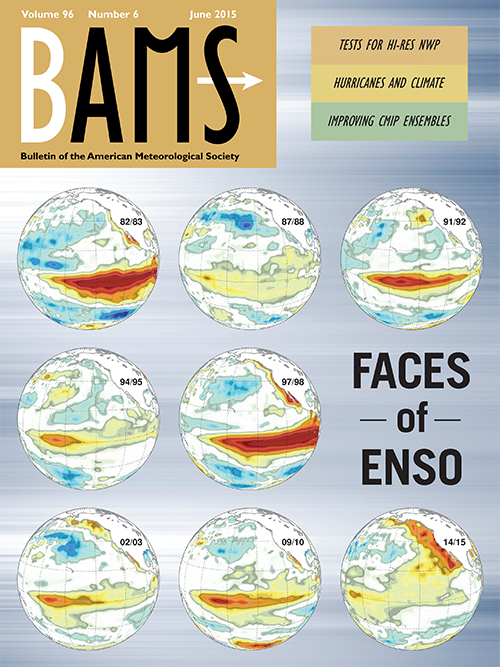Researchers examine whether distinct 'flavors' of El Niño/La Niña may exist
The El Niño / Southern Oscillation (ENSO) is Earth's strongest interannual climate fluctuation, impacting weather, ecosystems, and economies around the world. Differences in the details of the ENSO spatial pattern can have important consequences for both local and remote impacts. Understanding the range and origin of different ENSO 'types' could lead to more accurate predictions of ENSO impacts.
A new study co-authored by researchers at the ESRL Physical Sciences Laboratory (PSL), and colleagues from NOAA's Geophysical Fluid Dynamics Laboratory and 14 other institutions around the world, analyzes the diverse conditions and impacts associated with ENSO to better understand whether distinct 'types' of events exist. The article appears in the June 2015 issue of the Bulletin of the American Meteorological Society, which also features an image from the article on its cover.
Lead author Antonietta Capotondi, a CIRES researcher at PSL, is also co-chair of the U.S. Climate Variability and Predictability Program (US CLIVAR) – a national research program investigating the variability and predictability of the global climate system with a particular emphasis on the role the ocean plays.
"This study was motivated by the need to synthesize and better understand the large body of literature on the existence of different types of El Niño, as part of the US CLIVAR working group activities," says Capotondi.
Through examination of historical records and recent model simulations, the team has proposed viewing ENSO diversity as a continuum of variability with striking extremes, rather than two distinct types – as stressed by previous studies. In particular, warm events (El Niños) are generally more diverse than cold events (La Niñas), and stronger El Niños tend to exhibit their peak warm sea surface temperature (SST) anomalies (departures from normal) farther east. El Niño events of all types are often preceded, and perhaps triggered, by westerly wind events in the western and central equatorial Pacific. The equatorward spread of off-equatorial disturbances, as well as the initial heat content of the equatorial Pacific ocean can also play an important role in the development of different ENSO types.
"Although this is an important part of better understanding ENSO predictability, it's still unclear if different event types are associated with specific precursors," says Capotondi.
Present-day prediction systems can distinguish the 'flavor' of ENSO evolution up to six months in advance with some skill, while better predicting large eastern Pacific events. On longer time scales, simulations suggest that multi-decade prevalence of a given ENSO flavor can occur at random. These natural low-frequency variations may obscure changes in ENSO characteristics associated with global warming.
The details of ENSO sea surface temperature anomalies can have important consequences around the world. For example, for countries along the western coast of South America, SST anomalies in the eastern equatorial Pacific can influence rainfall amounts or affect fish populations, while events centered further west in the Pacific may not have any impact.
"A better understanding of the predictability of different ENSO types and the improvement of their prediction," says Capotondi, "are some of the most important next steps in ENSO research."
Posted: July 28, 2015
CIRES is a partnership between NOAA and the University of Colorado

Antonietta Capotondi, Andrew T. Wittenberg, Matthew Newman, Emanuele Di Lorenzo, Jin-Yi Yu, et al. (2015): Understanding ENSO Diversity. Bull. Amer. Meteor. Soc., 96, 921–938. https://doi.org/10.1175/BAMS-D-13-00117.1